Hawks In Arizona
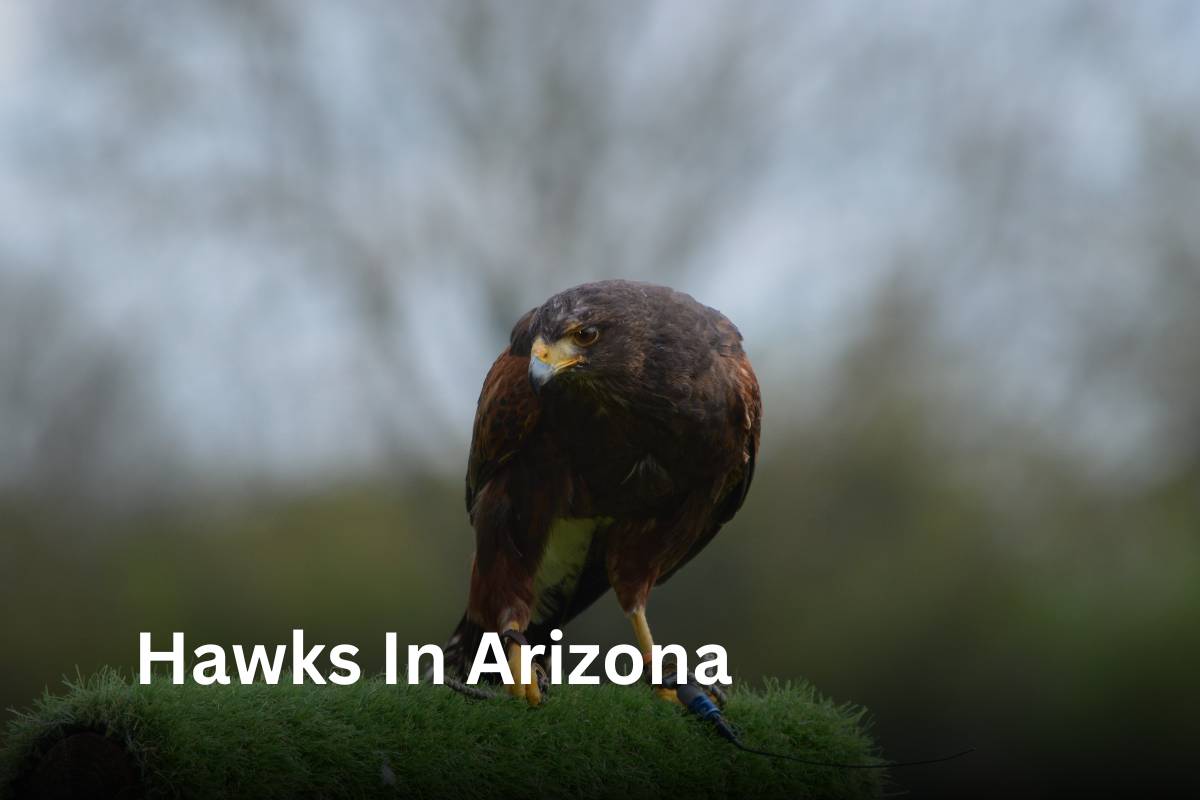
Arizona is home to many species of birds found in the United States. As of January 2023, the list of birds was listed out by the Arizona Bird Committee (ABC).
As per ABC, it has been revealed that there are 570 species of birds in Arizona. In the following blog post, we’ll delve into the fascinating world of different species of hawks that are found in Arizona state.
We will learn about the thrilling journey of these 14 species of hawks’ physical features, behavior, and feeding preferences in detail.
List Of 14 Hawks In Arizona:
- Ferruginous Hawk
- Common Black Hawk
- Gray hawk
- Swainson’s Hawk
- White-tailed Hawk
- Northern Harrier
- Short-tailed Hawk
- Broad-winged Hawk
- Zone-tailed hawk
- Red-tailed Hawk
- Red-shouldered Hawk
- Rough-legged Hawk
- Cooper’s Hawk
- Sharp-shinned Hawk
1. Ferruginous Hawk (Buteo regalis)
It is a large prey of birds that have distinctive identical markings in both sexes. The term “ferruginous” refers to the reddish-brown or rust color.
The ferruginous hawks have a reddish upper back, white breasts, pointed tips, brownish rust back, and wings. These species form two types of coloration i.e. light morph birds and dark morph birds.

Moreover, it has a white head with a dark streak that extends behind the eyes. At the time of the flight, the ferruginous hawks form a “V” shape and its underparts are light colored with dark legs.
Previously, it was called ferrugineous rough-leg which was closely related to the rough-legged hawk. Similar to rough-legged, the ferruginous hawks have rusty or whitetails, long broad wings, and legs feathered to the talons.
Size, Weight, Wingspan, and Lifespan of Ferruginous Hawk:
- Size: 22.1-27.2 in (56-69 cm)
- Weight: 34.5-73.2 oz (977-2074 g)
- Wingspan: 4 ft 7 inches (139 cm)
- Lifespan: Upto 20 years
Habitat: The ferruginous hawks’ preferred habitat is semiarid grassland, arid, riparian corridors, open areas, and rolling prairies. However, these hawks avoid narrow canyons, high elevations, and cliff areas.
Commonly, they breed in northern Arizona, southeastern Arizona, northern New Mexico, western Kansas, northwest Texas, and Canada.
Feeding: Being a large prey of birds, the ferruginous hawk hunts small as well as medium-sized mammals. On behalf of this, they also consume insects, birds, and reptiles.
2. Common Black Hawk (Buteogallus anthracinus)
The common black hawk’s scientific name is Buteogallus anthracinus. It is a bird of prey that belongs to the family Accipitridae.
In adults, they have broad wings which are mainly black or gray. Along with that, the adult common black hawks’ underparts are buff to whitish with dark blotches.
It also has a yellow bill with a pointed black tip and yellow legs and cere. One of the striking birds resembles the zone-tailed hawk.
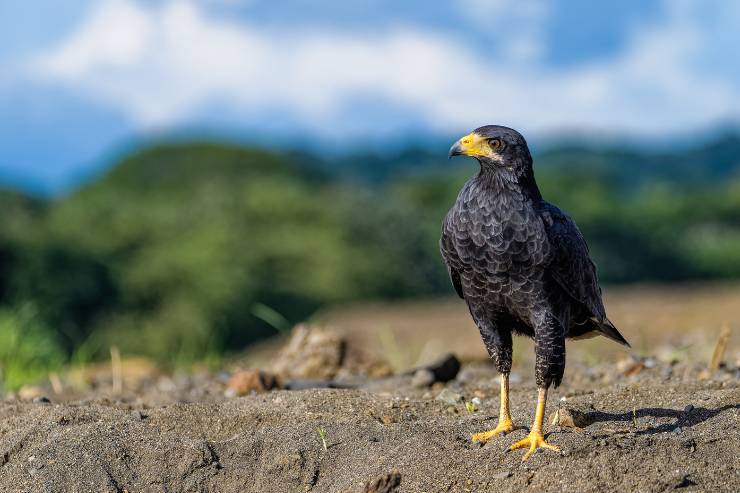
Size, Weight, Wingspan, and Lifespan of Common Black Hawk:
- Size: 17–21 inches (43-53 cm)
- Weight: 33 ounces (930 g)
- Wingspan: 50 inches (127 cm)
- Lifespan: 13 years
One of the oldest common black hawks was found in Arizona which was recorded to be at least seven years old.
Habitat: Mainly, their preferred habitat is coastal areas, mangrove swamps, dry open woodlands, and estuaries. These species of hawk are commonly found in Trinidad, the Lesser Antilles, Central America to Venezuela.
Feeding: The common black hawk is a migratory hawk that feeds on small vertebrates (such as crabs, and lizards), carrion, and crayfish. They also eat insects to get supplements.
3. Gray hawk (Buteo plagiatus)
The gray hawk is a small species of raptor commonly known as the Mexican goshawk. These adult hawks have short rounded wings and a long black and white banded tail.
Its distinctive physical features are a pale gray plumage, darker gray unpatterned upperparts, and lighter gray and white underparts. It has an orange legs.
While the juveniles enhance different plumage colors because of dominance. So, dull colors are used for camouflage.
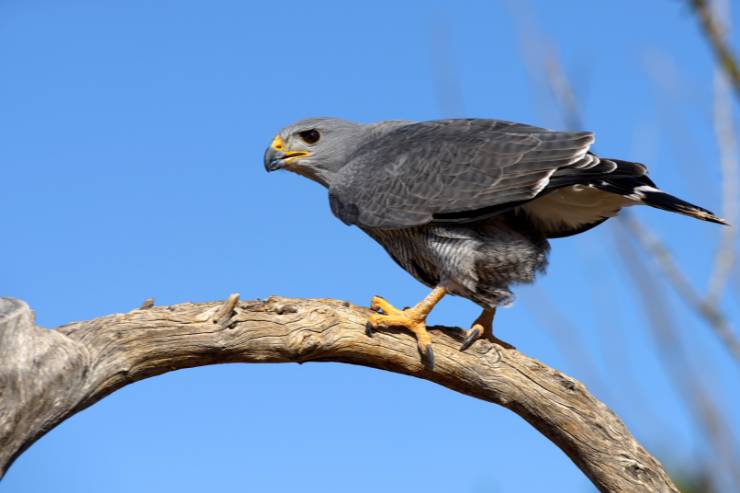
Likewise, immature hawks possess a pale-banded brown tail, dark brown top parts, and brown spots with white lower parts.
Size, Weight, Wingspan, and Lifespan of Gray Hawk:
- Size: 18–24 inches (46–61 cm)
- Weight: 16.8 ounces (475 g)
- Wingspan: 35 inches
- Lifespan: 10 to 12 years
Habitat: The gray hawk breeding habitat ranges from Northern and Central America, southern Arizona to central Texas. Both male and female hawks build nests and use their live twigs at the time of nesting.
Mainly, it can be observed in savanna, forest edges, river edges, thorn-scrub woodlands, and clearings.
Feeding: Its main diet is small mammals, lizards, snakes, large insects, frogs, and some birds. Usually, they sit in an open high-perch area to swoop their prey.
4. Swainson’s Hawk (Buteo swainsoni)
The Swainson’s hawk is a large bird species of order Accipitriformes that is colloquially known as the locust hawk or grasshopper hawk.
It is a medium-sized raptor that is long-winged with pointed wingtips. They have brown upper breasts with a hooded appearance. However, the researchers have revealed that there are two color variations of color.
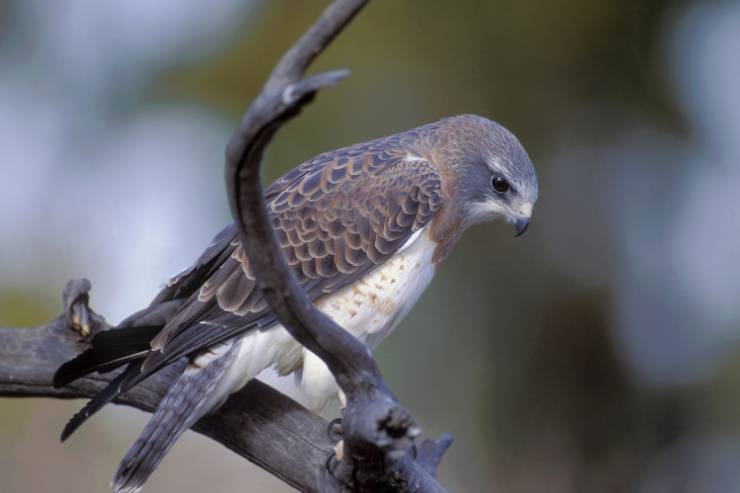
Out of them, 90% of individual hawks are light morphs and the rest are dark morphs which is common in the Far West.
Size, Weight, Wingspan, Bill, and Lifespan of Swainson’s Hawk:
- Size: 46-56 centimeters (18-22 inches)
- Wingspan: 119-150 centimeters (47-59 inches)
- Weight: 650-1100 grams (22.92-38.80 oz)
- Bill: 1.2–1.4 inches (3–3.5 cm)
- Lifespan: up to 15 years
According to the International Union for Conservation of Nature (IUCN), the Swainson’s hawk is not considered a threatened species. But, it was found to be more abundant.
However, the California Department of Fish and Game has classified these species of hawks as a threatened species. The population of Swainson’s hawk is declining rapidly due to the use of pesticides in its wintering grounds.
To control the growth of locusts and grasshoppers, farmers use DDT and monocrotophos to reduce it. But, these types of insects are inhaled by the Swainson’s hawk.
Habitat: It inhabits mainly in the spring and summer, and winters in South America. Along with that, the Swainson’s hawk often migrates in large flocks in Arizona during the spring season.
This hawk lives in open and semi-open areas such as cultivated lands, grasslands, savannas, prairies, and steppes.
Feeding: The Swainson’s hawk mostly feeds on three r’s. Such as their diet consists of rabbits, rodents, and reptiles. It might also catch insects in flight. They use several hunting techniques to catch their prey.
5. White-tailed Hawk (Geranoaetus albicaudatus)
The white-tailed hawk is a large, stocky species of hawk that belongs to the family Accipitridae. The adult hawks have grey on the upper parts and white on the lower parts as well as rump.
It exhibits a rusty red shoulder patch while sitting with its wings closed. They have a short tail which is white with a narrow black band near the end. Its bill is pale green, the beak is black, the iris is hazel, and the feet are yellow with black talons.
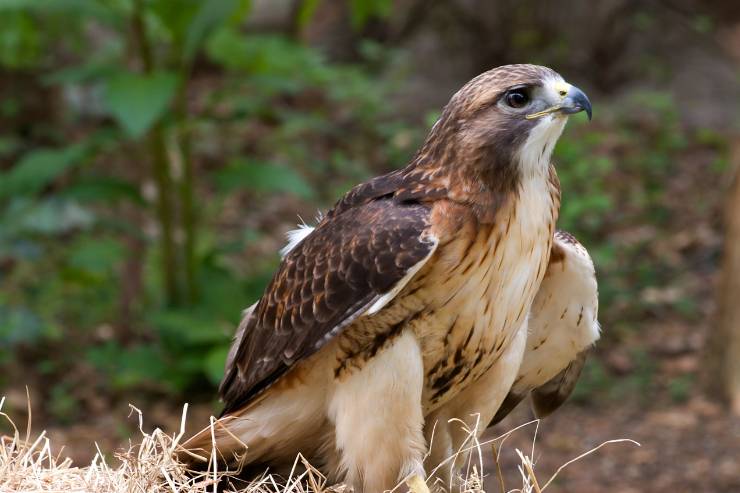
However, the immature hawks are darker than adults who appear to be black in faint light. Its tail color changes from brown to greyish with a hazy dark band as it grows mature.
Size, Weight, Wingspan, and Lifespan of White-tailed Hawk:
- Size: 17–24 inches (44–60 cm)
- Weight: 31.0-43.6 ounces (880-1235 g)
- Wingspan: 46–56 inches (118–143 cm)
- Lifespan: 10 years and 7 months old
According to the IUCN, the white-tailed hawk is listed as a globally threatened species.
Habitat: It lives in open or semi-open regions such as southern Texas grasslands, savannas, pastures, and prairies. The white-tailed hawk is not a migratory bird, but some of them migrate in regional movements when food is scarce.
Feeding: The diet of the white-tailed hawk varies according to its environment. They primarily consume frogs, snakes, and lizards. Occasionally, it eats blue crabs, beetles, grasshoppers, rattlesnakes, and other large insects.
6. Northern Harrier (Circus hudsonius)
The northern harrier is a bird of prey belonging to the Accipitridae family. This species of hawk is also known as a marsh hawk or ring-tailed hawk.
It is a medium-sized raptor that possesses a flat shape and owl-like face. They have a long tail, broad wings, and a sharply hooked small bill.

Size, Weight, Wingspan, and Lifespan of Northern Harrier:
- Size: 16–20 inches (41–52 cm)
- Weight: 10.6-26.5 oz (300-750 g)
- Wingspan:38–48 inches (97–122 cm)
- Lifespan: Upto 15 years
As per the IUCN Red List, the population of this species is declining more than 30% from the three generations. The conservation status of the northern harrier hawk is classified as least concern.
Habitat: Moreover, the northern harrier is mostly located in open areas, marshes, farmland coastal prairies, grasslands, and swamp areas.
It has been observed that the nests are built on the mound of dirt or the ground. It is a unique bird that looks similar to the large owl-like hawk. Most of the time til March it haunts in southeast Arizona.
Feeding: This hawk has a typical hunting behavior which primarily hunts small mammals. However, male hawks hunt birds (such as pipits, larks, and sparrows) in an open country.
Occasionally, they feed on insects like orthopterans, and amphibians like frogs, and reptiles.
7. Short-tailed Hawk (Buteo brachyurus)
The short-tailed hawk is an American bird of prey that belongs to the genus Buteo. It is not a true hawk which is also known as buzzard or buteo.
The adult light morph has broad wings that curve to the trailing edges of wings. It has white underparts and narrow bands in the tail.
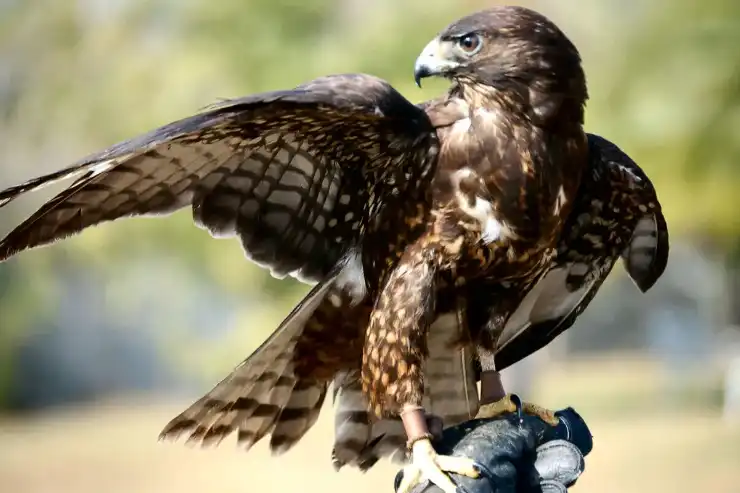
Similarly, the adult dark morph has a dark brown-black body and wing coverts. It has narrow white bands.
Short-tailed Hawk Size, Weight, and Wingspan:
- Size: 39-44 cm (15.3-17.3 inches)
- Weight: 385-480 g (13.6-16.9 ounces)
- Wingspan: 83-103 cm (32.7-40.5 inches)
In Arizona, the population of the short-tailed hawk is considered Imperiled as per NatureServe. However, the IUCN hasn’t mentioned this hawk as a threatened species.
Habitat: The short-tailed hawk is generally found in patchy woodlands near water, wooded savannah, and high pine-oak woodlands. In lowland foothills, they are commonly seen and visible by bird lovers.
Its breeding habitat ranges in the tropical and subtropical regions. They are found in the Mexico-Arizona mountainous border area, southern Florida, northern Argentina, and the Caribbean islands of Trinidad.
Feeding: This species of hawk is an aerial bird. Its diet consists of small songbirds like Mourning Dove and Sharp-shinned hawk. Occassionally, the short-tailed hawk consumes tree frogs, rodents, snakes, lizards, and insects.
8. Broad-winged Hawk (Buteo platypterus)
It is a medium-sized hawk widely distributed all over eastern North America, British Columbia, and Texas. Scientifically, the broad-winged hawk’s name is Buteo platypterus.
As raptors, these species of hawks are classified into two types of coloration, such as a dark morph with fewer white areas and a light morph that is more pale overall.
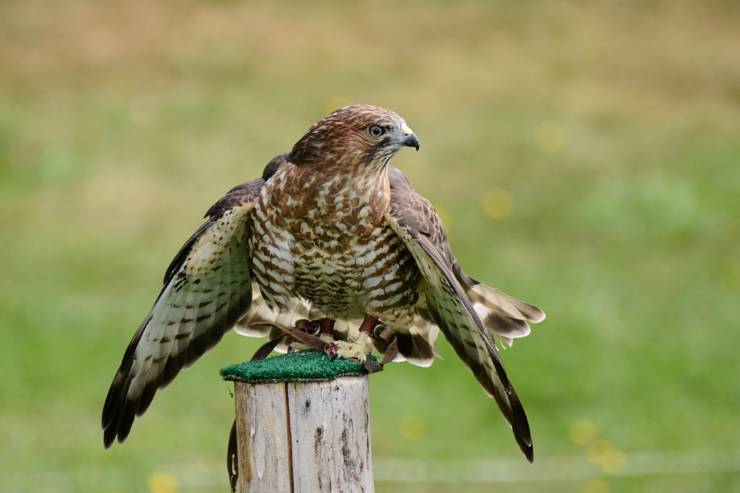
Relatively, the size of broad-winged hawk females is slightly larger compared to broad-winged hawk males. They have small pointed tips, barred underparts, and strong banded tails with dark edges of wings.
In adults, it has a dark brown color with a white belly and chest that has a horizontal barring.
Broad-winged Hawk Size, Weight, Wingspan, and Lifespan:
- Size: 13 to 17 inches (32 to 44 cm)
- Weight: 9.3 to 19.8 ounces (265 to 560 g)
- Wingspan: 29 to 39 inches (74 to 100 cm)
- Lifespan: 12 years
Globally, the population of broad-winged hawks is declining. As per the International Union for the Conservation of Nature (IUCN), the broad-winged hawk conservation status is the least concern.
Habitat: Their preferable habitat is to nest in dense deciduous or mixed deciduous-coniferous forests. Primarily, this hawk forages in meadows and wetlands.
The broad-winged hawk is a rare migrant hawk that is found across the state of Arizona. They are often seen in a wide range of areas in North America and South America ranging from the Southern part of Canada to Brazil.
During the winter season, it migrates to the forests of Central America, South America, Southern Mexico, and Florida.
Feeding: The broad-winged hawks are carnivores whose types of food mostly depend upon the season of the year. Its diet consists of reptiles, amphibians, insects, birds, and mammals.
In summer or nesting season, they eat voles, lizards, chipmunks, dragonflies, saturniid moth caterpillars, snakes, frogs, and crabs. This hawk tries to aim their target by sitting on the low branches of trees or hiding in the foliage to catch its prey.
9. Zone-tailed hawk (Buteo albonotatus)
It is a medium-sized hawk. The plumage of an adult zone-tailed hawk is black, with light gray flight feathers, and yellow legs and cere. It resembles the common black hawk.
The zone-tailed hawk is often confused with a Turkey Vulture. It has long broad wings with a large white band on the tail.
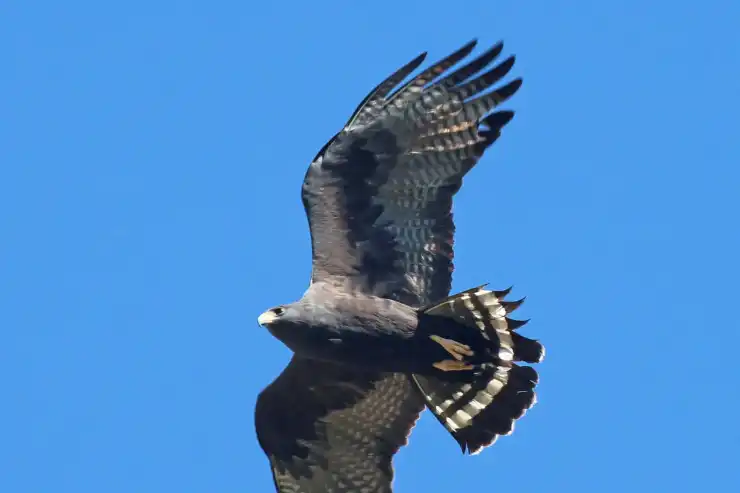
Zone-tailed Hawk Size, Weight, Wingspan, and Lifespan:
- Size: 18 to 22 inches (46 to 56 cm)
- Weight: 1.246–2.381 lbs (565–1,080 g)
- Wingspan: 46–55 inches (117–140 cm)
- Lifespan: 10 to 15 years
The conservation status of the zone-tailed hawk is least concern.
Habitat: Commonly, their breeding habitat ranges from some parts of southern Arizona, western Texas, New Mexico, and Central America into eastern Colombia.
In winter, they are often observed in the Yucatan Peninsula and Oaxaca. Mostly, it is spotted in rocky areas, hilly riverine woods, coniferous or pine-oak forests.
Feeding: Primarily, the zone-tailed hawk hunts those prey that is small in size. It is an active predator that preys mainly on small birds and mammals. Such as squirrels, mice, common collared lizards, and white-eared cotton rats.
Zone-tailed hawks do not prey on live animals. Besides this, it also feeds on young birds, amphibians, quail species, ground squirrels, and chipmunks.
10. Red-tailed Hawk (Buteo jamaicensis)
The red-tailed hawk is a partial migrant bird of prey native to North America. Sometimes, this hawk is also called a red-tail.
Notably, 14 subspecies have been recognized in the avian world that vary according to their ranges and coloration. Generally, the adult hawk has rufous-toned upper parts with extensive white spangling and a white tail.
The physical appearance of this hawk’s throat might vary in the young ones and adults. In younger hawks, the underparts are covered with a dark-brown spotting. While, in adult hawks, their throat represents a lighter brown necklace.
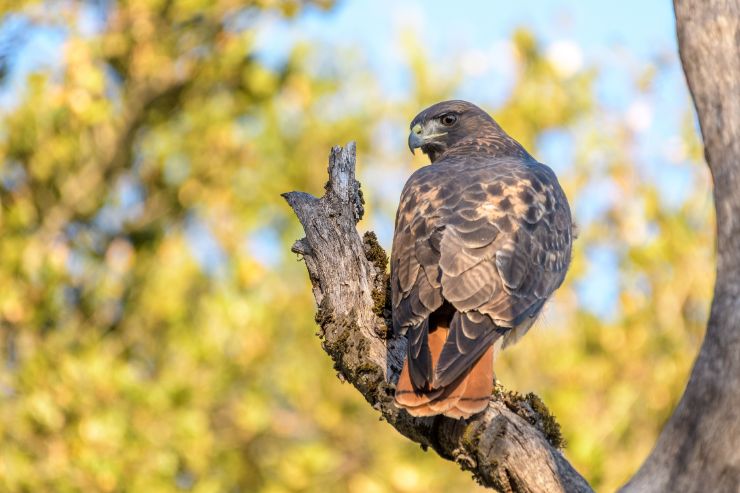
They have a slightly dark brown back with pale scapular feathers which form an imperfect “V” shaped on the back. The adult red-tailed hawk bill is dark, rufous brick-red tail in the above.
Male Red-tailed Hawk Size, Weight, and Wingspan:
- Size: 18 to 24 inches (45 to 60 cm)
- Weight: 1.52 to 2.87 lbs (690 to 1,300 g)
- Wingspan: 3 ft 5 in to 4 ft 8 inches (105 to 141 cm)
Female Red-tailed Hawk Size, Weight, and Wingspan:
- Size: 19 to 26 inches (48 to 65 cm)
- Weight: 1.766 to 3.799 lbs (801 to 1,723 g)
- Wingspan: 4 ft 10 inches (147 cm)
The average lifespan of red-tailed hawks is up to 20 years. According to the International Union for the Conservation of Nature (IUCN), the red-tailed hawks are listed as the least concern.
Habitat: This species of hawk is widely distributed in all parts of America. It is a diurnal raptor whose breeding habitat is considered to be one of the largest raptors on the Mexico border.
Throughout the year, the red-tailed hawk breeds on the southern shores of Great Bear Lake, Inuvik, Mackenzie River Delta, Yukon, and the Northwest Territories.
During the winter season, it migrates towards the south. While in October, the red-tailed hawk is abundant in Arizona. Their habitat is mostly in deciduous woodlands, foothills, deserts, parks, cemeteries, road verges, and pastures.
Feeding: It is a carnivorous. Their diet comprises small mammals like rodents, lagomorphs, rabbits, invertebrates, amphibians, reptiles, and birds.
11. Red-shouldered Hawk (Buteo lineatus)
The red-shouldered hawk is a medium-sized hawk that belongs to the genus of Buteo. The physical appearance of this hawk is slim-shaped overall, small head, and a long fairly banded black and white tail.
In adults, they have a reddish-brown on the chest and underparts, brownish heads, pale bellies, and dark upper parts with pale spots. However, the size of female hawks is slightly larger than male hawks.
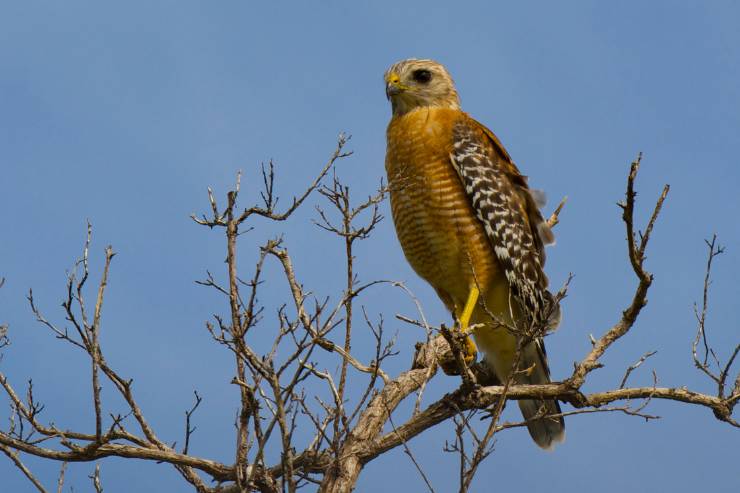
Whereas, the wings that are present on the upper parts of this hawk are heavier. It has a long yellow legs. The red-shouldered hawk’s wingspan is measured 94 to 110 cm.
Sometimes, the juveniles of the red-shouldered hawk are confused with the broad-winged hawks and red-tailed hawks. The lifespan of this hawk is about 20 years.
Male Red-shouldered Hawk Size and Weight:
- Size: 15 to 23 inches (38 to 58 cm)
- Weight: 1.21 lbs (550 g)
Female Red-shouldered Hawk Size and Weight:
- Size: 19 to 24 inches (47 to 61 cm)
- Weight: 1.5 lbs (700 g)
However, the oldest red-shouldered hawk was a female raptor that lived for at least 25 years and ten months old. Later on, in 2000 in California, the hawk was recaptured and rereleased during banding operations.
Habitat: It is a permanent resident in central Mexico throughout the year. It is a migratory hawk. Its breeding habitat ranges from eastern North America along with the coastal area of California to northeastern-central Mexico.
During the winter season, it is seen from Ohio, Arizona, and southern New England south to the Gulf Coast, Wisconsin, and Oklahoma.
Feeding: This species of hawks mainly prey with their talons on small mammals. Especially, mice, moles, rodents, chipmunks, ruffed grouse, flying squirrels, and large insects.
12. Rough-legged Hawk (Buteo lagopus)
The rough-legged hawk is a medium-large-sized raptor that is commonly known as the rough-legged buzzard. Traditionally, it is also termed the rough-legged falcon.
The plumage is brown, a fairly narrow wings, and has a black patch at the wrist. In light morph individuals, it is easily distinguishable by a square dark carpal patch with its white under-wing.
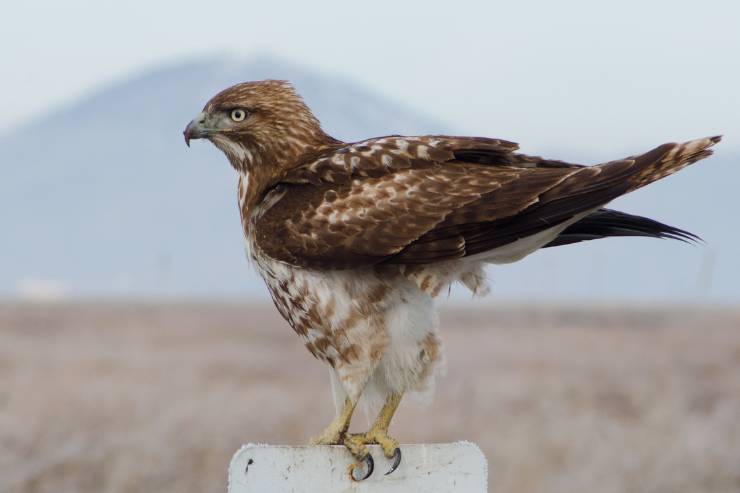
In like manner, the immature hawks have a light head and an extensive black belly patch. The appearance of a rough-legged hawk is more like an eagle.
Size, Weight, Wingspan, and Lifespan of Rough-legged Hawk:
- Size: 18.5-20.5 in (47-52 cm)
- Weight: 25.2-49.4 ounces (715-1400 g)
- Wingspan: 52.0-54.3 in (132-138 cm)
- Lifespan: 19 years old
The average lifespan of the rough-legged hawk is nearly 19 years old in the wild. As per the IUCN Red List, the rough-legged hawk is assessed as a least concern species.
Habitat: This species of hawk is found in arctic and subarctic regions during the breeding season. Such as Europe, North America, and Russia. Occassionally, they visit Arizona state during the winter seasons.
Mostly it breeds in taiga habitats, tundra habitats, marshes, prairies, and areas with plenty of unforested and open ground.
Feeding: The rough-legged hawk is carnivorous. They feed on small mammals including voles, lemmings, mice, squirrels, pikas, shrews, rats, and gerbils. The hawk opportunistically hunts its prey.
13. Cooper’s Hawk (Accipiter cooperii)
It is a medium-sized hawk that is most commonly native to the North American continent. Relatively, it is large and has moderate-length wings with moderately thick legs and toes.
Typically, these creatures have an erect posture with a long tail. Its upper parts are bluish-gray with a black cap and a red scarlet eye.

Along with that, their underparts are pale in color with a dense reddish barring. The cooper’s hawk has a small and strongly hooked bill. It is also known as bold and aggressive predators.
Cooper’s Hawk Size, Weight, Wingspan, and Lifespan:
- Size: 37-39 cm (14.6-15.3 inches)
- Weight: 220-410g (7.8-14.5 oz)
- Wingspan: 62-90 cm (24.4-35.4 inches)
- Lifespan: 12 years
It is listed as least concern according to the IUCN. As of now, the population of Cooper’s Hawks is increasing.
Habitat: The cooper’s hawk is found in various mixed forests, temperate deciduous forests, conifer forests, open woodlands, and floodplains. It is a partial migrant hawk.
Feeding: Their diet consists of birds and small mammals. It feeds on flickers, jays, robins, tree squirrels, mice, bats, and chipmunks.
14. Sharp-shinned Hawk (Accipiter striatus)
The sharp-shinned hawk is commonly known as the northern sharp-shinned hawk or sharpie. It is recognized as one of the smallest hawks that belongs to the genus Accipiter.
The female hawks are distinctly larger than that of male hawks. The adult sharp-shinned hawk has short broad wings, whitish-barred blackish flight feathers, and horizontal red-orange bars on the breast.
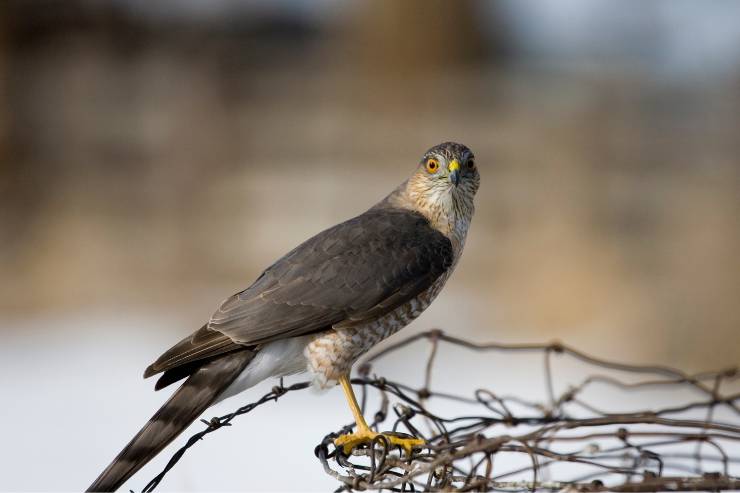
The upper parts are blue-gray and have a medium-length dark banded on the tails. The bill of this hawk is black and yellow cere. It also has a long, slender legs.
Male Sharp-shinned Hawk Size, Weight, and Wingspan:
- Size: 9.1 to 11.8 inches (23 to 30 cm)
- Weight: 2.9–4.1 ounces (82–115 g)
- Wingspan: 17 to 23 inches (42 to 58 cm)
Female Sharp-shinned Hawk Size, Weight, and Wingspan:
- Size: 11 to 15 inches (29 to 37 cm)
- Weight: 5.3 to 7.7 ounces (150 to 219 g)
- Wingspan: 23 to 27 inches (58 to 68 cm)
The lifespan of a sharp-shinned hawk is more than five years. As per the IUCN Red List, the conservation status of this hawk is least concern. Additionally, as mentioned by the U.S. Fish and Wildlife Service, it is listed as an endangered species.
Habitat: The small-sized hawks are widely spread in the Greater Antilles, Central America, North America, and South America. It is a montane breeder in Colorado and Arizona.
Typically, the sharp-shinned hawk is found in dense forests (such as conifers forest), lowlands as well as highlands of the subtropical regions, and woodlands.
Feeding: Mainly, their diet consists of small birds (such as wrens, sparrows, tits, thrushes, wood-warblers). Besides this, the sharp-shinned hawk rarely consumes large insects, lizards, snakes, and rodents.
Conclusion:
In conclusion, there have been different species of hawks that might be found in Arizona.
These majestic raptors play a vital role in maintaining the ecological balance of Arizona state’s diverse ecosystems.
The presence of these avian raptors from the Ferruginous Hawk to the Sharp-shinned Hawks adds charm to the resilience and beauty of Arizona’s wilderness.






